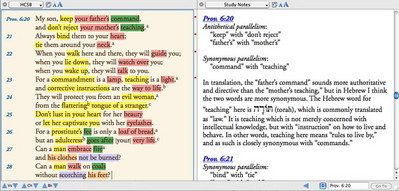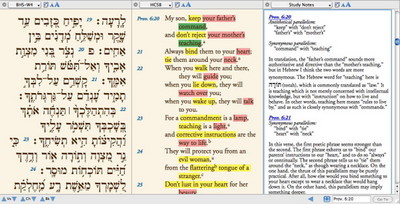I have always been fascinated by the parallelism which characterizes Hebrew poetry. I remember taking a seminary course in which I learned about the various kinds of Hebrew parallelism and realized that it is far more than just saying the same thing twice. Last night, my oldest daughter helped reawaken that fascination.
As we were about to conclude our family devotions, Bethany asked if she could read a passage from Proverbs that she had discovered earlier that day. It was Proverbs 6:16-19, which lists “Six things the LORD hates” and “seven” that are “detestable to Him.” After listening to her read the passage, my eye drifted down to verse 20, and I seized the opportunity to remind the kids of the need to “keep your father’s command” and not to “reject your mother’s teaching.” (Hey, we parents need all the support we can muster!)
After the kids went to bed, I started looking at verse 20 and the verses immediately following, and was struck by the different ways the author employed poetic parallelism to make his point. I therefore decided to examine the passage more closely using Accordance.
The first thing I did was to begin highlighting parallel words and phrases using different highlight styles. So in verse 20, I highlighted “keep” and “don’t reject” with one color, “your father’s” and “your mother’s” with another, and “command” and “teaching” with a third. I then did the same for the following verses.
Once I had identified which words and phrases were parallel, I decided to record my observations in my user notes. I opened a parallel pane with my Study Notes, then selected verse 20 and used the keyboard shortcut command-U to add a note on that verse. The edit window opened right above my notes panes enabling me to record my observations while still being able to look at the text.
I decided to record the type of parallelism being used in each verse, which led me to dust off an old seminary textbook (How to Read the Psalms by Tremper Longman III). Once I’d boned up on the major categories, I was able to observe the “antithetical parallelism” in verse 20. “Antithetical” does not mean that the author is trying to make two contrasting points, but that he is making the same point through the use of antonyms (“father’s” and “mother’s”) or by stating something both positively (“keep”) and negatively (“don’t reject”).
In general I think that exegetes can rely too heavily on categories and labels, but in this case, I found that trying to determine the kind of parallelism prompted me to ask questions of the text I might not otherwise have thought to ask. For example, I began to wonder if there was an implied contrast or antithesis between the “father’s command” and the “mother’s teaching.” In English the former sounds more authoritative and directive while the latter sounds more instructional, so I wondered if some kind of gender role distinction might be in view here.
That led me to examine the Hebrew words for “command” and “instruction.” Had I been using an English Bible with Key numbers, I could simply have triple-clicked each word to learn more about the Hebrew word it translates. In this case, I was not using a key numbered Bible, so I opened the Hebrew text in a third parallel pane and used the Instant Details box to find the words in question. I immediately saw that the word for teaching in this verse is torah, which is often translated as “law.” Triple-clicking the word took me to HALOT where I could confirm that this word is not used for “teaching” in the sense of intellectual knowledge, but for instruction on how to live. In other words, “teaching” in this verse means something like “rules to live by” and so is closely synonymous with “commands.” I therefore concluded that this verse was not implying any distinction between the commands given by the father and the teaching given by the mother. Rather than “antithetical parallelism,” I classified this parallelism as “synonymous.”
By working my way through the text like this, I began to make all kinds of interesting observations. For example, verses 22 and 23 each contain three parallel phrases, and together they seem to form a chiasm. That is, the first phrase of verse 22 is related to the last phrase of verse 23, while the four phrases in the middle all use similar imagery. Before I knew it, I had recorded quite a bit of commentary on this passage and felt I had a deeper understanding of its meaning. The next time you’re studying a passage of Hebrew poetry, don’t just focus on “getting to the point”; take the time to appreciate the artistry with which that point is made.



